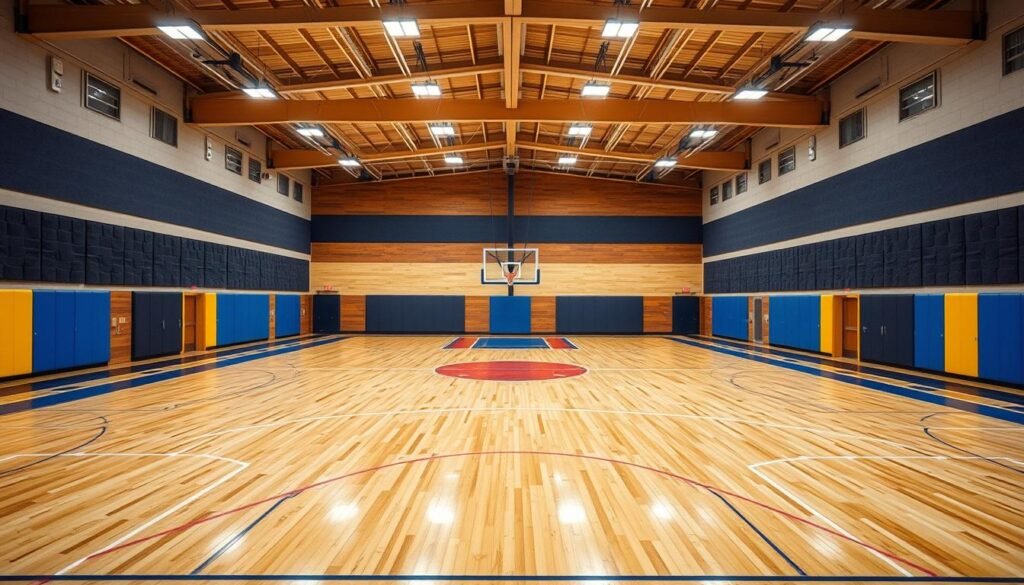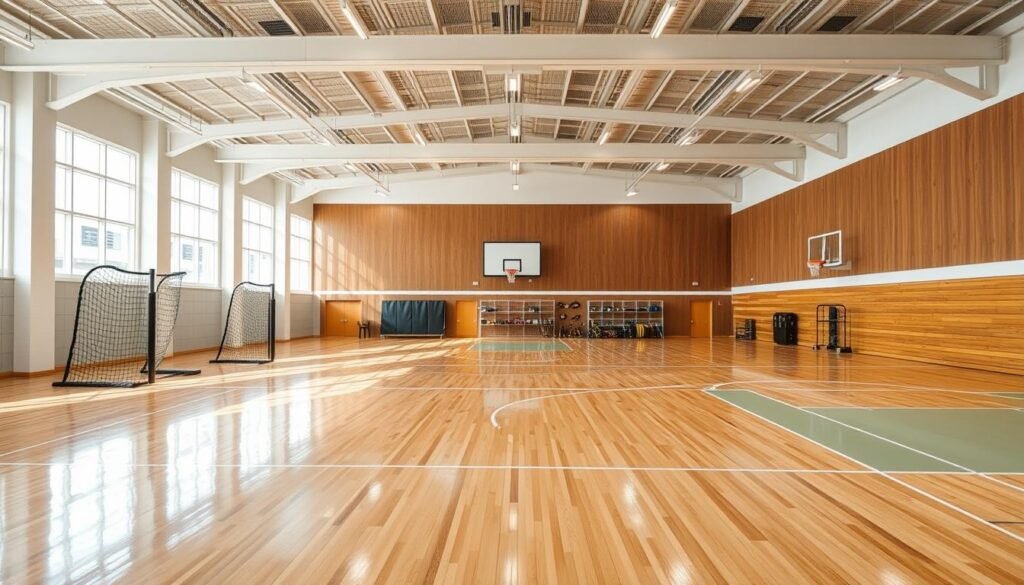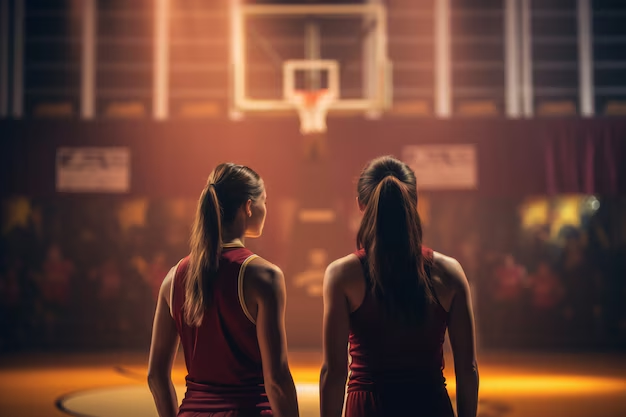Indoor sport facility have many benefits over outdoor ones. They can be used all year, no matter the weather. This means athletes can train and compete in a controlled environment, free from extreme weather.
These facilities also offer a safe and comfortable place to play. They have good lighting, quality surfaces, and amenities like locker rooms. This makes games and practices more enjoyable for everyone involved.
Key Takeaways
- Year-round accessibility for sports teams and athletes
- Comfortable playing conditions with climate control and efficient lighting
- Enhanced safety features for players and spectators
- Low maintenance requirements compared to outdoor facilities
- Ability to accommodate a variety of indoor sports and events
Year-Round Accessibility
Indoor sports facilities are great because they can be used all year. Outdoor sports often get cancelled because of bad weather. But, indoor places stay the same no matter the weather, helping athletes keep their schedules on track.
Functional Throughout the Year
Indoor sports places can handle many sports, like basketball and ice hockey. This makes them perfect for all kinds of sports all year. It’s great for athletes who need to keep practicing, no matter the weather.
| Outdoor Sports | Indoor Sports |
|---|---|
| Subject to cancellations due to severe weather | Unaffected by weather conditions |
| Inconsistent playing conditions | Consistent playing conditions |
| Difficult to maintain a regular practice schedule | Allows for consistent practice and training |
Indoor sports places offer a steady, controlled environment all year. This helps athletes stay ready for games and tournaments. It’s a big plus for sports fans and facilities.
Comfortable Playing Conditions

An indoor sports facility offers a controlled and comfortable environment. This enhances the experience for athletes and spectators. The climate-controlled temperature lets players compete without worrying about the weather.
Efficient lighting systems provide plenty of light, avoiding glare or poor visibility. Modern facilities have high-quality playing surfaces, like hardwood or artificial turf. These surfaces offer better traction and cushioning than outdoor fields.
Comfortable bleacher seating and other recreational opportunities add to the fun. This makes the environment great for both athletic performance and enjoyment.
Hosting athletic competitions, trade shows, and dance competitions in an indoor arena floor is a big plus. It provides a consistent and reliable playing surface, no matter the event. This involves considering the needs of various users.
It ensures the facility can handle a wide range of activities. This is done without using too much space or requiring a lot of maintenance.
| Outdoor Playing Field | Indoor Sports Facility |
|---|---|
| Subject to weather conditions | Climate-controlled environment |
| Inconsistent playing surface | High-quality playing surfaces |
| Limited seating capacity | Comfortable bleacher seating |
| Requires regular field maintenance | Low maintenance requirements |
The benefits of an indoor sports facility’s playing conditions make it a great choice. It’s perfect for hosting a variety of athletic competitions, trade shows, and dance competitions all year round. It ensures a comfortable and consistent experience for everyone involved.
Indoor Sport Facility Enhances Safety

Safety is key in sports training. Indoor sport facilities are much safer than outdoor ones. They remove risks from weather conditions and playing conditions, making a safe place for athletes to practice.
Indoor sports facilities have special flooring systems. These floors absorb shock and prevent slipping. They use rubber flooring or foam-padded hardwood, meeting strict safety standards.
Indoor facilities also control the climate. This means no extreme temperatures or heavy rain to worry about. Athletes can train without weather worries.
Indoor sports facilities reduce injuries from weather and surfaces. This makes a safer place for athletes of all levels. They can train with confidence, knowing they’re in a safe environment.
| Safety Feature | Benefit |
|---|---|
| Specialized flooring | Provides excellent shock absorption and slip resistance, reducing the risk of injuries |
| Controlled climate | Eliminates exposure to extreme temperatures, heavy rain, and other weather-related hazards |
| High-quality materials | Meet stringent safety standards set by sports governing bodies |
Indoor sport facilities focus on safety. This lets athletes improve and excel in their sports. With special flooring, controlled weather conditions, and strict safety, these facilities are the best for training and competition.
Low Maintenance Requirements

Indoor sports facilities have a big advantage when it comes to maintenance. They are not affected by harsh weather like rain, snow, or extreme temperatures. This means their playing surfaces, equipment, and amenities last longer, saving on repairs and replacements.
Having lower maintenance needs is a big plus for indoor sports facilities. It lets owners and operators spend more on improving the experience for everyone. They can invest in new technologies, upgrade facilities, and offer top-notch service for all sports.
- Hardwood floors and artificial turf last much longer without the need for frequent resurfacing or replacement.
- Equipment and amenities are not exposed to the elements, further reducing maintenance needs.
- The saved resources can be reinvested into improving the facility, such as adding specialized features like batting cages, rock climbing walls, or futsal courts.
Indoor sports facilities can focus on giving a great experience to all, no matter their age or skill. They can host a variety of events, games, and tournaments.
“The reduced maintenance requirements of indoor sports facilities allow us to prioritize the needs of our athletes and event organizers, creating a truly exceptional experience for all who visit our multi-use space.”
Also Read : What Are Essential Passing Techniques For Indoor Volleyball?
Conclusion
Indoor sports facilities offer many benefits for year-round training and events. They provide a controlled, climate-regulated environment. This lets athletes play without worrying about the weather.
The high-quality playing surfaces and lighting systems enhance the experience. This is true for both players and spectators.
Indoor facilities also need less maintenance, making them more enjoyable and cost-effective. They are perfect for hosting various sports activities. An indoor athletic center, indoor gymnasium, or indoor fitness center creates lasting memories and improves the overall experience for everyone.
These facilities are designed with energy efficiency in mind. They offer amenities like diving boards and racquetball courts. An indoor recreation center or indoor sporting arena positively impacts the local community.
They provide a safe, comfortable, and accessible place for sports. These complexes help grow and develop sports in the region.
FAQs
Q: What are the main benefits of having an indoor sports complex?
A: Indoor sports complexes provide a controlled environment for training, allowing athletes to practice year-round regardless of severe weather. They also cater to a wide range of sports, including basketball, volleyball, and gymnastics, making them versatile spaces for various athletic activities.
Q: How does building an indoor sports complex impact local sports?
A: Building an indoor sports complex enhances local sports infrastructure by providing dedicated athletic facilities for youth sports and adult leagues. This can lead to increased participation in sporting events and foster a sense of community among sports enthusiasts.
Q: What types of events can be hosted in an indoor sports complex?
A: An indoor sports complex can host a variety of events, including sports tournaments, cheerleading competitions, and multi-sport events. These event centers are designed to accommodate both training and competitions, making them ideal for a range of indoor sports.
Q: What is the average cost per square foot for building an indoor sports complex?
A: The cost per square foot for building an indoor sports complex can vary widely based on design, location, and materials used, such as a fabric building. It’s essential to analyze specific needs and budget considerations to determine the overall investment required.
Q: How can an indoor sports complex provide a return on investment?
A: An indoor sports complex can offer a return on investment by attracting sports tournaments and events, generating revenue through facility rentals, and increasing local participation in athletic programs. This can lead to enhanced visibility for sponsors and a boost to the local economy.
Q: What features should an indoor sportsplex include to be effective?
A: An effective indoor sportsplex should include multipurpose athletic facilities, an indoor track, meeting rooms, and a scoreboard system. These features ensure that the facility can cater to a variety of sports and events, enhancing its usability.
Q: Why are indoor sports complexes considered versatile spaces?
A: Indoor sports complexes are considered versatile spaces because they can accommodate a wide range of sports and activities, from basketball and volleyball to gymnastics and lacrosse. This flexibility allows for year-round use and the ability to host multiple events simultaneously.
Q: Can an indoor sports complex support youth sports development?
A: Yes, an indoor sports complex plays a crucial role in youth sports development by providing safe and accessible training environments. It encourages young athletes to participate in various sports, fostering skill development and teamwork in a structured setting.
Q: What are the advantages of using a fabric building for an indoor sports facility?
A: Fabric buildings offer several advantages for indoor sports facilities, including cost-effectiveness, quick construction timelines, and flexibility in design. They can be tailored to meet specific needs and provide ample space for athletic activities while ensuring durability.
Q: How can local communities benefit from having access to an indoor sports complex?
A: Local communities benefit from an indoor sports complex by gaining access to premier indoor sports facilities, which can enhance community engagement and promote healthy lifestyles. They also serve as a hub for social interaction and foster talent development in various sports.
